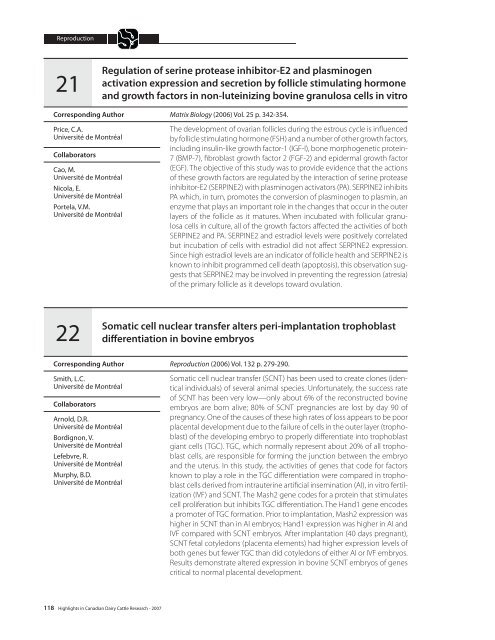A52-75-2007E.pdf - AgroMedia International Inc
A52-75-2007E.pdf - AgroMedia International Inc
A52-75-2007E.pdf - AgroMedia International Inc
Create successful ePaper yourself
Turn your PDF publications into a flip-book with our unique Google optimized e-Paper software.
Reproduction21Regulation of serine protease inhibitor-E2 and plasminogenactivation expression and secretion by follicle stimulating hormoneand growth factors in non-luteinizing bovine granulosa cells in vitroCorresponding AuthorPrice, C.A.Université de MontréalCollaboratorsCao, M.Université de MontréalNicola, E.Université de MontréalPortela, V.M.Université de MontréalMatrix Biology (2006) Vol. 25 p. 342-354.The development of ovarian follicles during the estrous cycle is influencedby follicle stimulating hormone (FSH) and a number of other growth factors,including insulin-like growth factor-1 (IGF-I), bone morphogenetic protein-7 (BMP-7), fibroblast growth factor 2 (FGF-2) and epidermal growth factor(EGF). The objective of this study was to provide evidence that the actionsof these growth factors are regulated by the interaction of serine proteaseinhibitor-E2 (SERPINE2) with plasminogen activators (PA). SERPINE2 inhibitsPA which, in turn, promotes the conversion of plasminogen to plasmin, anenzyme that plays an important role in the changes that occur in the outerlayers of the follicle as it matures. When incubated with follicular granulosacells in culture, all of the growth factors affected the activities of bothSERPINE2 and PA. SERPINE2 and estradiol levels were positively correlatedbut incubation of cells with estradiol did not affect SERPINE2 expression.Since high estradiol levels are an indicator of follicle health and SERPINE2 isknown to inhibit programmed cell death (apoptosis), this observation suggeststhat SERPINE2 may be involved in preventing the regression (atresia)of the primary follicle as it develops toward ovulation.22Somatic cell nuclear transfer alters peri-implantation trophoblastdifferentiation in bovine embryosCorresponding AuthorSmith, L.C.Université de MontréalCollaboratorsArnold, D.R.Université de MontréalBordignon, V.Université de MontréalLefebvre, R.Université de MontréalMurphy, B.D.Université de MontréalReproduction (2006) Vol. 132 p. 279-290.Somatic cell nuclear transfer (SCNT) has been used to create clones (identicalindividuals) of several animal species. Unfortunately, the success rateof SCNT has been very low—only about 6% of the reconstructed bovineembryos are born alive; 80% of SCNT pregnancies are lost by day 90 ofpregnancy. One of the causes of these high rates of loss appears to be poorplacental development due to the failure of cells in the outer layer (trophoblast)of the developing embryo to properly differentiate into trophoblastgiant cells (TGC). TGC, which normally represent about 20% of all trophoblastcells, are responsible for forming the junction between the embryoand the uterus. In this study, the activities of genes that code for factorsknown to play a role in the TGC differentiation were compared in trophoblastcells derived from intrauterine artificial insemination (AI), in vitro fertilization(IVF) and SCNT. The Mash2 gene codes for a protein that stimulatescell proliferation but inhibits TGC differentiation. The Hand1 gene encodesa promoter of TGC formation. Prior to implantation, Mash2 expression washigher in SCNT than in AI embryos; Hand1 expression was higher in AI andIVF compared with SCNT embryos. After implantation (40 days pregnant),SCNT fetal cotyledons (placenta elements) had higher expression levels ofboth genes but fewer TGC than did cotyledons of either AI or IVF embryos.Results demonstrate altered expression in bovine SCNT embryos of genescritical to normal placental development.118 Highlights in Canadian Dairy Cattle Research - 2007





